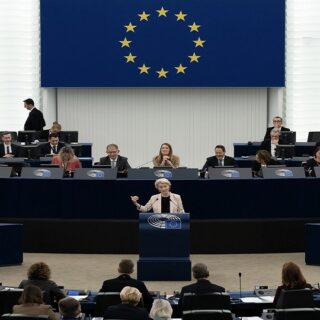
How we regard the Russian Revolution of 1905-1907 often determines how we understand the nature of political terrorism in the Russian Empire.
If we only focus on the mass movements of the revolution, then terrorism during this period remains the Great Unknown.
What makes it so ironic about terrorism being the Great Unknown is that the Revolution of 1905-1907 was the first European revolution with such a large terrorist component. Furthermore, terrorism, in its own way, became a mass movement for politically conscious sectors of Russian society.
We can recall some of the key events of the revolution such as:
1. Bloody Sunday on January 9, 1905 (old calendar) when police and soldiers fired upon unarmed workers and their families bringing a petition to Tsar Nicholas II.
2. The October General Strike brought the country to a standstill, and it forced the tsar to sign the Manifesto of October 17 that promised political freedom and a State Duma. This turned Russia into a semi-parliamentary state.
3. The “Days of Freedom” when many people celebrated the granting of political freedom and a Duma.
4. A wave of pogroms by supporters of the tsar that were directed mostly against Jews, but also against students and members of the intelligentsia.
5. Elections and the opening and dissolution of the First Duma (April 27, 1906 to July 8, 1906) and Second Duma (February 20, 1907 to June 3, 1907).
6. The law of June 3, 1907 radically changed the election laws. Historians usually regard this law as the end of the revolution just as they regard Blood Sunday as the start of it.
Demonstrations, strikes, riots, pogroms, mutinies, uprisings, and elections are all mass events. Terrorist acts are carried out by individuals or small groups. Histories of the Revolution of 1905 to 1907 have usually focused on mass protest movements, particularly of workers and peasants who made up most of the population of the empire.
Political reasons partly explain the emphasis on mass movements in the revolution. As Soviet and later Russian historian S.V.Tiutiukin noted <> Thanks to this schematic approach, historians idealized the proletariat and Bolsheviks, demonized non-Bolshevik parties, especially socialist and liberal parties, ignored the reformist actions of the government and the degree of mass counterrevolutionary movements. [1, cc.4-5]
Foreign historians focused on mass movements in the revolution. Some historians mentioned some spectacular terrorist acts carried out by the Combat Organization of the Party of Socialists-Revolutionaries (SRs) in 1904-1905.
Of course, the mass movements in the Revolution of 1905-1907 were extremely diverse and often distinguished this revolution from previous European revolutions. Under the category of mass violent and non-violent protest movements, we can include the movements of workers, peasants and other rural inhabitants, professional people, employees, and other urban strata, university and other post-secondary students, secondary school students, advocates of women’s rights, soldiers, sailors, ethnic and religious minorities along with the mass movements of empire-wide, ethnic minority, Russian nationalist, regional, and local parties and movements spanning the political spectrum from right to left. Women often participated in many mass movements as well as teenagers and even children.
It is extremely important to emphasize that protest movements included antirevolutionary and counterrevolutionary movements. Like too many historians of the French Revolution, too many historians of the Russian Revolutions of 1905-1907 and 1917-1922 find it distasteful and difficult to write about mass antirevolutionary and counterrevolutionary movements.
The violence of these movements usually was expressed through uprisings, strikes, demonstrations, mutinies in the army and fleet, pogroms, peasant partisan activities in the forests and mountains, seizure and destruction of state and private property, inter-ethnic and inter-religious conflicts, for example, between Christian Armenians and Muslim Azerbaijanis, the overthrow of local authorities and the establishment of alternative authority right up to forming village republics, political and criminal murders of government and private people, frequent use of Lynch Law [самосуд] and other forms of popular vengeance. [2, c.51]
The Revolution of 1905-1907 included conflicts not only between the government and different strata of the population, but also between different strata and within them.
There were conflicts on political, social (estates and classes), ethnic, religious, regional, local, age, gender, and other lines.
It would be no exaggeration to call the Revolution of 1905-1907 Europe’s first major civil war of the 20th century. Terrorism was part of this civil war.
I have repeatedly emphasized the massiveness of terrorism in the Russian Empire and argued that it broke all European records. In fact, terrorism kept going in Russia long after the revolution was crushed.
American historian Anna Geifman gave the following calculations on the massiveness of terrorism. Between October 1905 to the end of 1907, the number of government representatives—both civilian and military—reached 4,500. Victims from the general population included 2,180 killed and 2,530 wounded. The total number of victims was more than 9,000. Between January 1908-May 1910, the government recorded 19,957 terrorist acts and revolutionary robberies–<<expropriations>>. The dead included 732 government persons and 3,051 private persons and the wounded included 1,022 government persons and 2,829 private persons. The number of victims was 7,634. Geifman estimated that the total number of victims of revolutionary terrorism between 1901-1911 was about 17,000. [3, p. 21] What is interesting is that terrorism took on a life of its own and could continue even when mass movements had been crushed by the government.
In its own way, terrorism was a mass movement because it was widely used by many leftist parties and movements and supported by many liberals. As well, many conservatives took an ambivalent stance on terrorism and often withheld their support from the government. The political parties and movements largely represented society and the intelligentsia — the more politically conscious elements of Russian society. Terrorism was one major expression of the discontent and hostility that the parties had toward the government. In fact, terrorism was a major derivative of the hostile and strained relationships between government and society, as represented by the intelligentsia and political movements.
We need to look even further at why terrorism remains a Great Unknown.
Sources Used
- Тютюкин, С. В. Предисловие. Первая революция в России: взгляд через столетие. (Introduction. The First Revolution in Russia: a Glance over One Century) Москва: Памятники исторической мысли, 2005.
- Рокки, Т. Российская революция 1905-1917 гг. как первая гражданская война в Европе в ХХ веке. (Rocchi, T. The Russian Revolution of 1905-1907 as the first civil war in Europe in the 20th century). История. Историки. Источники. 2022, № 4, сс. 46-55. https://s.esrae.ru/history2014/pdf/2022/4/362.pdf
- Geifman, Anna. Thou shalt kill: revolutionary terrorism in Russia, 1894-1917. Princeton NJ: Princeton University Press, 1993. Русский перевод в электронной форме. Гейфман, Анна. Революционный террор в России, 1894— 1917. Москва: КРОН-ПРЕСС, 1997. https://royallib.com/book/geyfman_anna/revolyutsionniy_terror_v_rossiihtml





